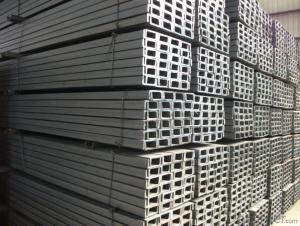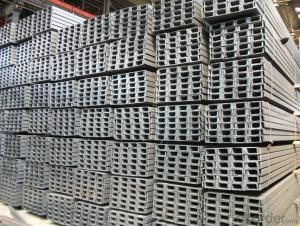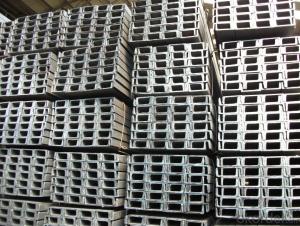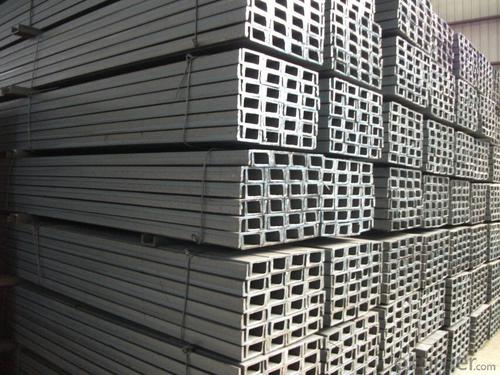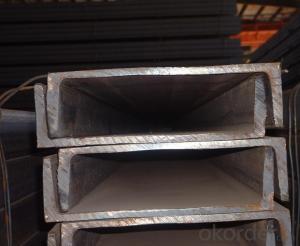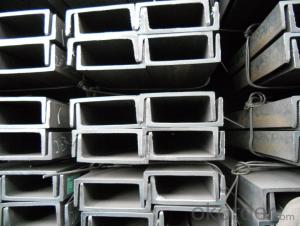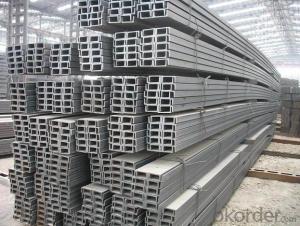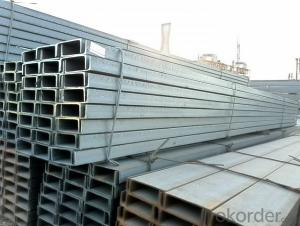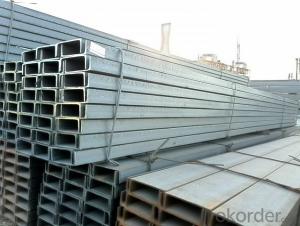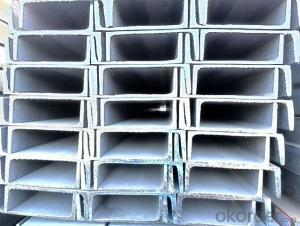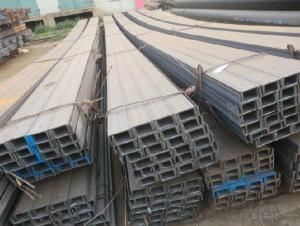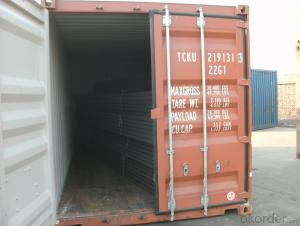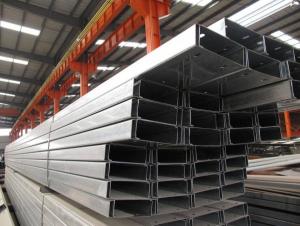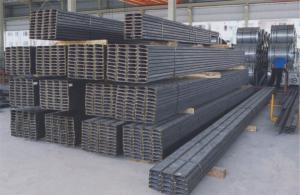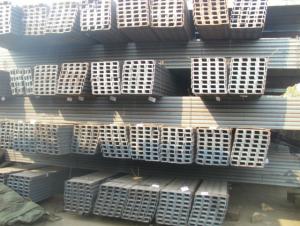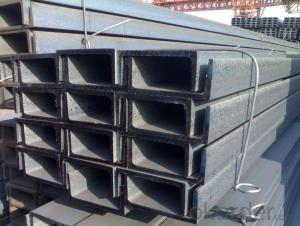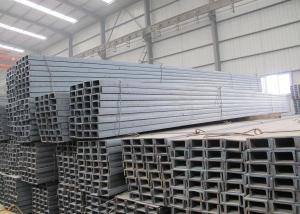U-Channels Source from China Market with Best Price
- Loading Port:
- Tianjin
- Payment Terms:
- TT OR LC
- Min Order Qty:
- 25 m.t
- Supply Capability:
- 10000 m.t/month
OKorder Service Pledge
OKorder Financial Service
You Might Also Like
Specification
OKorder is offering high quality Hot Rolled U-Channels at great prices with worldwide shipping. Our supplier is a world-class manufacturer of steel, with our products utilized the world over. OKorder annually supplies products to European, North American ,Africa and Asian markets. We provide quotations within 24 hours of receiving an inquiry and guarantee competitive prices.
Product Applications:
Hot Rolled U-Channels are ideal for structural applications and are widely used in the construction of buildings and bridges, and the manufacturing, petrochemical, and transportation industries.
Product Advantages:
OKorder's U-Channels are durable, strong, and resist corrosion.Most important ,our price is evry competitive.
Main Product Features:
· Premium quality
· Prompt delivery & seaworthy packing (30-45 days after receiving deposit)
· Corrosion resistance
· Can be recycled and reused
· Mill test certification
· Professional Service
· Competitive pricing
Product Specifications:
Manufacture: Hot rolled
Grade: Q235/SS400
Certificates: ISO, SGS, BV, CIQ
Length: 6m – 12m, as per customer request
Packaging: Export packing, nude packing, bundle
JIS U CHANNEL | Standard | Sectional | Dimension |
| Mass: |
(mm) | (mm) | (mm) | (mm) | ||
50x25 | 50 | 25 | 3.0 | 6.00 | 2.37 |
75X40 | 75 | 40 | 3.8 | 7.00 | 5.30 |
75X40 | 75 | 40 | 4.0 | 7.00 | 5.60 |
75X40 | 75 | 40 | 4.5 | 7.00 | 5.85 |
75X40 | 75 | 40 | 5.0 | 7.00 | 6.92 |
100X50 | 100 | 50 | 3.8 | 6.00 | 7.30 |
100X50 | 100 | 50 | 4.2 | 6.00 | 8.03 |
100X50 | 100 | 50 | 4.5 | 7.50 | 8.97 |
100X50 | 100 | 50 | 5.0 | 7.50 | 9.36 |
125X65 | 125 | 65 | 5.2 | 6.80 | 11.66 |
125X65 | 125 | 65 | 5.3 | 6.80 | 12.17 |
125X65 | 125 | 65 | 5.5 | 8.00 | 12.91 |
125X65 | 125 | 65 | 6.0 | 8.00 | 13.40 |
150x75 | 150 | 75 | 5.5 | 7.30 | 14.66 |
150x75 | 150 | 75 | 5.7 | 10.00 | 16.71 |
150x75 | 150 | 75 | 6.0 | 10.00 | 17.90 |
150x75 | 150 | 75 | 6.5 | 10.00 | 18.60 |
150x75 | 150 | 75 | 6.5 | 10.00 | 24.00 |
200X80 | 200 | 80 | 7.5 | 11.00 | 24.60 |
FAQ:
Q1: Why buy Materials & Equipment from OKorder.com?
A1: All products are carefully selected from China's most reliable manufacturing enterprises. Through its ISO certifications, OKorder.com adheres to the highest standards and a commitment to supply chain safety and customer satisfaction.We can guarantee the quality!
Q2:What's your payment terms ?
A2: We can accecpt T/T,LC at sight and time LC.
Q3: You selling on theoretical weight basis or actual weight basis ?
A3: Yes, we can do both ,deponding on buyers' needs .
Images
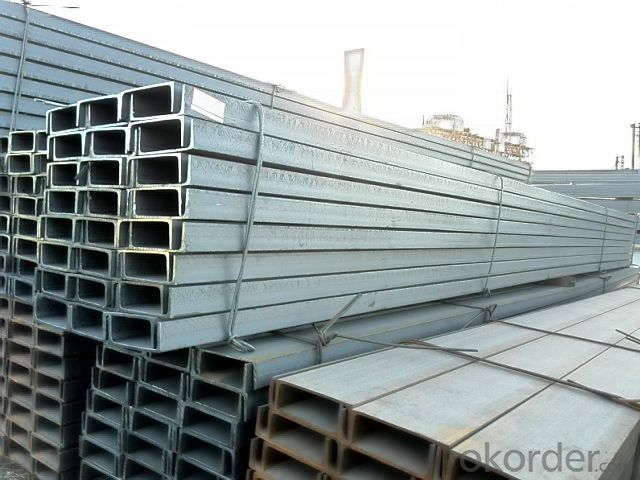
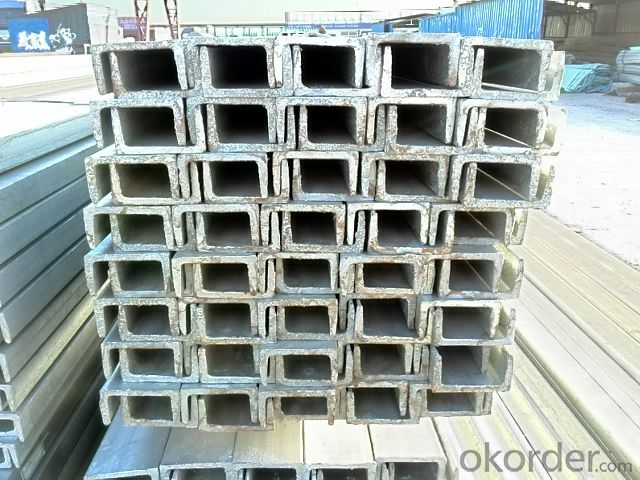
- Q: What are the different connection methods for steel channels?
- There are several different connection methods for steel channels, depending on the application and desired structural integrity. Some of the most common connection methods include: 1. Welding: This is a popular method for connecting steel channels. Welding involves melting the edges of the channels and fusing them together using heat. It provides a strong and durable connection, but it requires skilled welders and can be time-consuming. 2. Bolting: Bolting is another common method for connecting steel channels. It involves using bolts and nuts to secure the channels together. This method is relatively quick and easy, and it allows for disassembly if needed. However, it may not provide as strong a connection as welding. 3. Riveting: Riveting is a method where metal pins or rivets are used to join the steel channels together. This technique is commonly used in heavy-duty applications and offers a strong and permanent connection. However, it requires special tools and skilled labor to perform. 4. Adhesive bonding: Adhesive bonding involves using high-strength adhesives or epoxy to join steel channels together. This method can provide a strong and flexible connection, but it may not be suitable for all applications and requires appropriate surface preparation and curing time. 5. Mechanical connectors: Mechanical connectors, such as beam hangers or brackets, can be used to connect steel channels. These connectors provide a quick and easy method for joining channels, but they may not offer the same level of structural integrity as other methods. It's important to consider factors such as load bearing capacity, structural design requirements, and ease of installation when choosing a connection method for steel channels. Consulting with a structural engineer or a construction professional can help ensure the appropriate connection method is selected for a specific project.
- Q: How do steel channels contribute to energy conservation?
- Steel channels contribute to energy conservation in several ways. Firstly, steel channels are used in the construction of energy-efficient buildings and structures. The strength and durability of steel channels allow for the creation of well-insulated walls and roofs, reducing energy loss through heat transfer. Additionally, steel channels are often employed in the construction of renewable energy systems such as solar panel supports and wind turbine towers, enabling the generation of clean energy. Moreover, steel channels can be recycled, reducing the need for new steel production and saving energy that would have been used in the manufacturing process. Overall, steel channels play a vital role in promoting energy conservation through their use in efficient construction, renewable energy systems, and the sustainability of materials.
- Q: Can steel channels be used in theater and stage construction?
- Yes, steel channels can be used in theater and stage construction. Steel channels provide structural support and can be used for framing, rigging systems, and creating platforms and walkways. They are durable, versatile, and can withstand heavy loads, making them ideal for use in theater and stage construction.
- Q: Can steel channels be powder-coated?
- Yes, steel channels can be powder-coated.
- Q: Can steel channels be used for fencing purposes?
- Indeed, steel channels possess the ability to serve as fencing components. With their versatility and strength, steel channels prove to be an exceptional option for fencing purposes. They allow for the creation of robust and enduring fence structures capable of enduring diverse weather conditions and ensuring security. Furthermore, steel channels offer ease of customization to accommodate various fencing designs and sizes, and they can be seamlessly integrated with other materials such as wire mesh or panels to enhance both security and visual appeal. Moreover, their resistance to corrosion guarantees a lasting solution for fencing projects.
- Q: What are the load-bearing capabilities of steel channels?
- The load-bearing abilities of steel channels vary depending on several factors like dimensions, material grade, and the specific application at hand. Steel channels are designed to offer structural support and are commonly utilized in construction and engineering projects. The shape and size of a steel channel significantly impact its load-bearing capacity. The channel's depth, width, and thickness determine its overall strength and ability to endure loads. Additionally, the material grade of the steel channel plays a vital role in determining its load-bearing capabilities. Generally, higher grades of steel possess greater tensile and yield strengths, enabling them to support heavier loads. Engineers typically rely on industry standards and reference tables to precisely determine the load-bearing capabilities of a steel channel. These resources provide guidance on the safe working loads for different sizes and grades of steel channels. When calculating the maximum load a steel channel can bear, engineers also consider factors like the type of loading (e.g., static or dynamic), the support conditions (e.g., fixed or pinned), and the required safety factor. It is important to acknowledge that factors such as the quality of fabrication, the presence of defects or damage, and the overall structural design can also influence load-bearing capabilities. Therefore, consulting a qualified engineer or referring to appropriate design codes and regulations is crucial when determining the load-bearing capabilities of steel channels for a specific application.
- Q: You can use steel purlin
- It is better not to use C steel. The channel steel made of 1.2--3.0MM is too heavy and the price is high
- Q: Are there any specific safety considerations when working with steel channels?
- Yes, there are specific safety considerations when working with steel channels. Some of these considerations include: 1. Personal protective equipment (PPE): It is essential to wear appropriate PPE when working with steel channels, such as safety goggles, gloves, steel-toed boots, and a hard hat. This helps protect against potential hazards such as flying debris, sharp edges, and falling objects. 2. Handling and lifting: Steel channels can be heavy and cumbersome, so it is important to use proper lifting techniques and equipment to prevent strain or injury. This may include using lifting straps, slings, or cranes to safely lift and move the channels. 3. Sharp edges and corners: Steel channels often have sharp edges and corners that can cause cuts or punctures. It is important to handle them with care and use appropriate tools, such as gloves, to avoid direct contact with these sharp areas. 4. Structural stability: When working with steel channels in construction or fabrication, it is crucial to ensure the structural stability of the setup. This includes properly securing the channels in place, using appropriate support systems, and following engineering specifications to prevent collapse or accidents. 5. Fire hazards: Steel channels are highly conductive and can quickly transfer heat, making them a potential fire hazard. It is important to take precautions to prevent sparks or open flames from coming into contact with the channels, especially in environments where flammable materials are present. 6. Slips, trips, and falls: Working with steel channels can involve working at heights or on elevated surfaces. It is important to maintain good housekeeping practices, such as keeping work areas clean and clear of obstructions, using proper ladder or scaffolding systems, and using fall protection equipment when necessary to prevent slips, trips, and falls. By considering these safety precautions and following best practices, the risk of accidents and injuries can be greatly reduced when working with steel channels.
- Q: How many meters per ton is channel ten?
- Channel ten is about 100 meters per ton.
- Q: How do steel channels perform under seismic loads?
- Steel channels can perform very well under seismic loads due to their inherent properties and design characteristics. Steel channels are typically used as structural elements in buildings and bridges to provide support and stability. When subjected to seismic loads, steel channels exhibit excellent strength and ductility, allowing them to withstand the dynamic forces generated by an earthquake. The high tensile strength of steel ensures that the channels can resist bending and distortion, while their ductility allows them to absorb and dissipate energy during seismic events. Moreover, steel channels can be designed and reinforced to enhance their seismic performance. Engineers can incorporate additional reinforcement, such as diagonal bracing or moment connections, to further enhance the channels' resistance to seismic forces. These reinforcements help distribute the forces more evenly throughout the structure, reducing the likelihood of localized damage or failure. In addition to their strength and ductility, steel channels also offer other advantages in seismic design. They are lightweight compared to other building materials, which reduces the overall mass of the structure and, consequently, the seismic forces acting on it. Steel channels can also be easily fabricated and installed, allowing for more efficient construction and potentially shorter downtime after an earthquake. Overall, steel channels are an excellent choice for seismic-resistant construction. Their inherent strength, ductility, and design flexibility make them highly capable of withstanding seismic loads and ensuring the safety and stability of structures in earthquake-prone areas.
Send your message to us
U-Channels Source from China Market with Best Price
- Loading Port:
- Tianjin
- Payment Terms:
- TT OR LC
- Min Order Qty:
- 25 m.t
- Supply Capability:
- 10000 m.t/month
OKorder Service Pledge
OKorder Financial Service
Similar products
Hot products
Hot Searches
Related keywords
